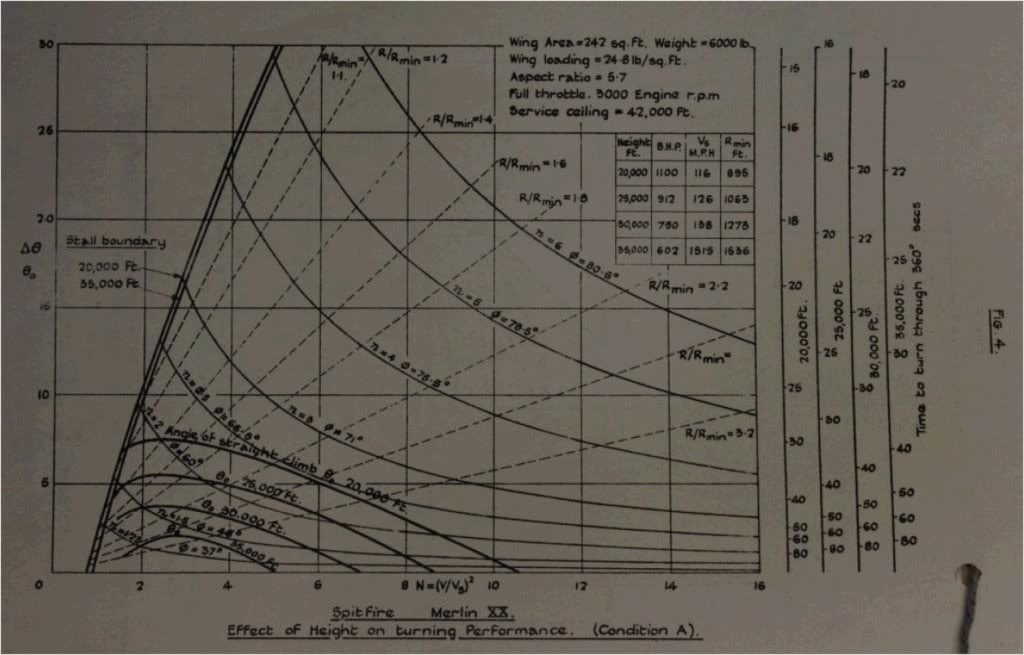
 |
|
#211
|
|||
|
|||
|
|
|
#212
|
|||
|
|||
|
I think this "G" is in fact a Buchon.
|
|
#213
|
|||
|
|||
|
Quote:
2. Even at constant KEAS speed and constant power, the resulting force, thrust, decreases when the altitude increases because force is power divided with true speed. To maintain given angle of bank at given KEAS, power must increase with altitude. |
|
#214
|
|||
|
|||
|
IvanK,
Could you please post parts of the report on turning performance at 20k? TIA |
|
#215
|
|||
|
|||
|
This is I think the only relevant bit that includes Sustained turn boundaries for 20,000',25,000',30,000', and 35,000'. "Angle of straight Climb" is Ps=0
 
Last edited by IvanK; 06-05-2012 at 06:11 AM. |
|
#216
|
|||
|
|||
|
Thanks IvanK,
So power is higher, 1100hp at 20k, than 1050hp at 12k. Time to turn 360deg is about 30s at 20k, while it was 18.6s at 12k. Last edited by MiG-3U; 06-05-2012 at 05:35 AM. |
|
#217
|
|||
|
|||
|
Quote:
Fun to watch but not even anecdotical evidence on how close the Spit and the 109 were. Last edited by 41Sqn_Stormcrow; 06-05-2012 at 06:48 AM. |
|
#218
|
|||
|
|||
|
It's a bit offtopic, but I never quite understood this 'Buchon' thing. Sure the Buchon handles slightly differently (from what I gather, directional stability was worse than on the 109, which already exhibited low directional stability characteristics), but in essence it was just a German built G-series airframe, with a very similar Merlin/HS engine wrapped onto it.
__________________
Il-2Bugtracker: Feature #200: Missing 100 octane subtypes of Bf 109E and Bf 110C http://www.il2bugtracker.com/issues/200 Il-2Bugtracker: Bug #415: Spitfire Mk I, Ia, and Mk II: Stability and Control http://www.il2bugtracker.com/issues/415 Kurfürst - Your resource site on Bf 109 performance! http://kurfurst.org 
|
|
#219
|
|||
|
|||
|
A Merlin installation v a DB605 installation is significantly different though.
Though I havent seen any Specfic excess power differences between the two I am sure they would be significant thus affecting sustained turn and climb performance. My Gut feeling is the DB605 variant would be the lesser performing aeroplane. Last edited by IvanK; 06-05-2012 at 09:00 AM. |
|
#220
|
|||
|
|||
|
The additional data posted by IvanK now gives the engine power as well and the turn time at 20,000 ft can as MIG-3U points out be read out of that figure to be in then order of 30 s. In fact the same report contains an even more precise figure of radius 1045 ft, bank angle 51 degrees and turn time 31.5 s in table 4 on page 4.
While we are waiting for Crummps 21 s 68 degree bank proof here are some C++ simulation results showing the relative performance between the 1.3 ata Me109E and Spitfire Mk1 at +6.25 boost: As expected the Spitfire is somewhat better at 20,000 ft due to the lower wing loading. However, the interesting thing is however that at low level (1 km) my simulations show that while the Spitfire turn better at low speeds, the Me109E turns better than the +6.25 boost Spitfire Mk1 at TAS speeds over 290 Km/h. However, if one assumes the +12 boost then it is of course no contest, either at low or higher speeds. Last edited by KG26_Alpha; 06-07-2012 at 02:17 PM. Reason: Removed part of post |
 |
|
|